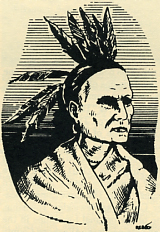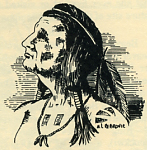
Click Here to Return To Milestones Vol 22 No 3

Our county has a rich Indian heritage. The Indians living in our valleys during the historic period were here only from about 1725 to 1758, but they left us a colorful legacy of place names. Here they are, with what is known of their origin.
ALIQUIPPA
Queen Aliquippa, queen of legend. Many residents of Aliquippa are convinced that their city was named for the Indian queen who once lived there, but the facts are different. The city of Aliquippa received its name from the Pittsburgh and Lake Erie Railroad who built an amusement park in what is now West Aliquippa in the 1880's and, in accordance to their policy, gave it the name of an Indian personality (others along the line were Shannopin, Kiasutha, and Monaca.) Aliquippa was a Seneca woman of some importance who lived near the forks of the Ohio. She met with George Washington in 1753 at the site of McKeesport. History records her as living near the mouth of Chartiers Creek; in New Castle, Delaware; and at Aughwick. There is no evidence that she ever lived at or visited the future site of the city of Aliquippa.
BEAVER
Beaver County, Beaver Borough, Beaver Falls, Big Beaver, South Beaver Township, Beaver River, Little Beaver Creek; the list goes on. There is much controversy as to the source of the name of Beaver Borough. A state historical marker in town attributes it to King Beaver (Tamaqui or Amockwi), a chief of the Delaware Indian tribe. Others claim it was named for the beaver, for which the river and other towns were named. In the historical Indian period, a village called Shingas Town was located here. Shingas was one of two brothers of King Beaver.
Fort McIntosh was built here during the
Revolutionary War by General Lachlan McIntosh, long after the
Indian inhabitants had moved westward. The Beaver River was named
"Amahkwi-sipu" (there are many spelling variations of
all Indian names) which meant "beaver stream" to the
Delawares and "Tankamahkwisipu" was Little Beaver Creek.
South Beaver Township, now much reduced in size, was one of the
six original townshipsof Beaver County in 1800.
BLACKHAWK
This is the name of a village on Lisbon Road (the "Tuscarawas Trail") on the border of Ohioville and South Beaver Township; a school district in northwestern Beaver County; and a road leading west from Chippewa Township through South Beaver (which does not go through Blackhawk village). The village came first and was probably named for its post office, established 1837. Blackhawk was a Sauk Indian Chief who led an insurrection ("Blackhawk's War") in Illinois in 1832. The newspapers of the time played up Blackhawk as a major adversary of president Andrew Jackson. The war didn't amount to much. And Blackhawk never set foot in Beaver County.
CHIPPEWA
Chippewa Township was the name chosen by its residents when South Beaver Township was divided in 1816. The Chippewa were a tribe principally located in the western Great Lakes region and were not known to have inhabited Western Pennsylvania in any significant numbers. One source gives the meaning of the name as "to roast until puckered up", referring to the puckered seam in their moccasins. Another claims that the name comes from the word "Chipwayonwok" which means "tailskins", referring to the nature of their dress. The Chippewa, like the Delawares and the Shawnees, were of the Algonquian lingistic stock.
CONNOQUENESSING
This beautiful Creek flows through northeastern Beaver County and enters the Beaver River just at the Beaver-Lawrence County line. Its name probably derives from the word "Gunachquenessink" which means "for a long way straight". Another source suggests that it comes from a chief named Conoquieson. Washington records crossing the Connoquenessing in 1753, at a place called "Murdering Town". In 1947, the Reader's Digest listed Connoquenessing as one of the ten most beautiful place names in America.
CROW
Little is known about the Indian chieftain known as Crow, who left his name on Crow's Run (New Sewickley to Conway), Crow's Run Road, of course, and Crow's Island in the Ohio River. There was a village known as Crow's Town (also called "Mingo Cabins") located in what is now Conway Yards. A significant Indian trail, taken by George Washington in 1753, followed Crow's Run northeast toward Venango.
LOGSTOWN
This name lives on as a section of northeastern Aliquippa, nearly erased by urban development and in Logstown Run, which flows under Franklin Avenue in Aliquippa. The original Logstown was across the river in what is now Harmony Township. Called "Chiningue" by the French (which means "beaver"), Logstown was one of the most important Indian towns in the state. Its name came from the log cabins in the village. The Iroquois claimed the land and were among the principal inhabitants of Logstown, along with the Delawares and Shawnees. An impressive number of historically important people lived at or near Logstown or visited here during its brief heyday. George Washington was here twice (1753 and 1770). Others included George Croghan, Christian Frederick Post, John Gibson, Alexander McKee, Conrad Weiser, and Captain Celeron de Bienville, who claimed the land for France.
The leading Indian resident was the "Half-King" Tanacharison, who, along with his subordinate and successor, Monacatootha, supervised affairs among the Delawares and Shawnees.
MONACA
The town in the bend of the Ohio bears part of the name of Monacatootha, an Oneida warrior chief also known as Scaroyady. Monacatootha (which means "Great Arrow") was a representative of the Iroquois Confederacy with the authority to supervise affairs among the Delawares and Shawnees in that area. He met with Washington in Logstown in 1753. He was a strong friend of the English and campaigned against the French. Monaca Borough (formerly Philipsburgh until 1892) took its name from a P. & L E. Railroad station at the east end of town.
OHIO
Ohioville Borough, Ohioview village (in Industry Borough). The Ohio River flows from east to west through Beaver County, reaching its northernmost point at Rochester. Ohio is a Seneca name and is shown on the earliest French maps, translated as "La Belle Riviere", or "the beautiful river". Another author suggests the "Bloody River", which it certainly was in the years of the Indian wars. The name may be related to "Ohiopyle", which means "waters whitened by froth". The Delawares called the river "Kit-hanne", which means " great river", or "main stream". This is the origin of Kittanning. The Indians and the French considered the Allegheny and the Ohio to be one river.
RACCOON
Raccoon Creek, which flows from Washington County through Southside Beaver County, received its name from the Algonquian word "aroughcoune". The Delawares called it "Nachenumhanne" or "Raccoon stream". Colonel Brodhead reported in 1779 to George Washington the capture of two boys by the Indians along this stream, one of many Indian raids in the Raccoon valley. Raccoon Township was, of course, named or the creek.
SEWICKLEY
North Sewickley Township, New Sewickley Township, Big Sewickley Creek. This name is derived from one of the divisions of the Shawnee tribe. The original name could have been "Asswikales" or "Thewegila" depending on the source. The Sewickley division was one of the principal clans from which the head chief of the Shawnees was selected (the other was the Chillicothe clan). There were many Sewickley towns in Western Pennsylvania. The name came to Beaver County as Sewickley Township, one of the original townships in the land obtained from Allegheny County in 1800.
SHENANGO
Shenango Road passes through Chippewa Township and Big Beaver. The name is said to be a corruption of the word "Ochenango" which means "large bull thistles". Shenango may be related to the word "Chiningue", which the French used to describe Logstown, and which means "beaver". Most significantly, Shenango is one of the two rivers which meet in Lawrence County to form the Beaver River (the other is the Mahoning River). An important Indian trail followed the Shenango River to Kuskuski, a major Delaware town near New Castle, then down the Beaver to Shingas' Town. In a slightly different form, Chenango is the name of a river in New York.
TAMAQUI
This Delaware chieftain (also known as Amockwi) leaves his name on a housing project in Vanport Township, Tamaqui Village. King Beaver (Tamaqui means Beaver) was a leader of the Turkey clan ("Unilachtigo clan") of the Delawares and a friend of the Pennsylvania settlers. Brother of head chief Shingas, he was considered chief of many Delawares in the region around the Ohio and Beaver rivers.
TUSCARAWAS
An ancient Indian trail, "the Great Trail" or "Tuscarawas Trail" led from the forks of the Ohio, across the Beaver River and along the ridge now followed by Tuscarawas Road (and Lisbon Road) in Brighton Township. Tuscarawas was the name of an important Delaware village on the Tuscarawas River in central Ohio. This village was the headquarters of King Beaver, after he left the mouth of the Beaver following the fall of Fort Duquesne in 1758. The Great Trail was followed by Colonel Bouquet in 1764 and by General McIntosh in 1778 on his way to establish Fort Laurens. The name does not appear to be related to Tuscarora, an Indian tribe akin to the Iroquois.
